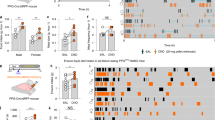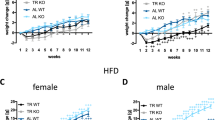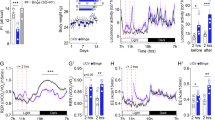Abstract
INTRODUCTION: The purpose of this study was to test the continuing validity of the hypothesis that neuropeptide Y (NPY) produced in the brain controls food intake through an interaction with the NPY Y5 receptor subtype.
METHODS: The hypothesis was tested using CGP 71683A a potent and highly selective non-peptide antagonist of the NPY Y5 receptor which was administered into the right lateral ventricle of obese Zucker fa/fa rats.
RESULTS: Intraventricular injection of 3.4 nmol/kg NPY increased food intake during a 2 h test period. Doses of CGP 71683A in excess of 15 nmol/kg (i.cv.) resulted in blockade of the increase in food intake produced by NPY. Repeated daily injection of CGP 71683A (30–300 nmol/kg, i.cv.) immediately before the dark phase produced a dose-dependent and slowly developing decrease in food intake. CGP 71683A has a low affinity for NPY Y1, Y2 and Y4 receptors but a very high affinity for the NPY Y5 receptor (Ki, 1.4 nM). Surprisingly, CGP 71683A had similarly high affinity for muscarinic receptors (Ki, 2.7 nM) and for the serotonin uptake recognition site (Ki, 6.2 nM) in rat brain. Anatomic analysis of the brain after treatment with CGP 71683A demonstrated an inflammatory response associated with the fall in food intake.
CONCLUSIONS: While the fall in food intake in response to CGP 71683A may have a Y5 component, interactions with other receptors or inflammatory mediators may also play a role. It is concluded that CGP 71683A is an imprecise tool for investigating the role of the NPY Y5 receptor in the control of physiological processes including food intake.
This is a preview of subscription content, access via your institution
Access options
Subscribe to this journal
Receive 12 print issues and online access
$259.00 per year
only $21.58 per issue
Buy this article
- Purchase on Springer Link
- Instant access to full article PDF
Prices may be subject to local taxes which are calculated during checkout





Similar content being viewed by others
References
Bernardis LL, Bellinger LL . The dorsomedial hypothalamic nucleus revisited: 1998 update Proc Soc Exp Biol Med 1998 218: 284–306.
Sahu A, Sninsky CA, Phelps CP, Dube MG, Kalra PS, Kalra SP . Neuropeptide Y release from the paraventricular nucleus increases in association with hyperphagia in streptozotocin-induced diabetic rats Endocrinology 1992 131: 2979–2985.
Stricker-Krongrad A, Kozak R, Burlet C, Nicolas JP, Beck B . Physiological regulation of hypothalamic neuropeptide Y release in lean and obese rats Am J Physiol 1997 273: R2112–R2116.
Yoshihara T, Honma S, Honma K . Effects of restricted daily feeding on neuropeptide Y release in the rat paraventricular nucleus Am J Physiol 1996 270: E589–E595.
Marin-Bivens CL, Kalra SP, Olster DH . Intraventricular injection of neuropeptide Y antisera curbs weight gain and feeding, and increases the display of sexual behaviors in obese Zucker female rats Regul Pept 1998 75-76: 327–334.
Hulsey MG, Pless CM, White BD, Martin RJ . ICV administration of anti-NPY antisense oligonucleotide: effects on feeding behavior, body weight, peptide content and peptide release Regul Pept 1995 59: 207–214.
Ishihara A, Tanaka T, Kanatani A, Fukami T, Ihara M, Fukuroda T . A potent neuropeptide Y antagonist, 1229U91, suppressed spontaneous food intake in Zucker fatty rats Am J Physiol 1998 274: R1500–R1504.
Blomqvist AG, Herzog H . Y-receptor subtypes—how many more? Trends Neurosci 1997 20: 294–298.
Wyss P, Stricker-Krongrad A, Brunner L, Miller J, Crossthwaite A, Whitebread S, Criscione L . The pharmacology of neuropeptide Y (NPY) receptor-mediated feeding in rats characterizes better Y5 than Y1, but not Y2 or Y4 subtypes Regul Pept 1998 75–76: 363–371.
Schaffhauser AO, Whitebread S, Haener R, Hofbauer KG, Stricker-Krongrad A . Neuropeptide Y Y1 receptor antisense oligodeoxynucleotides enhance food intake in energy-deprived rats Regul Pept 1998 75–76: 417–423.
Wieland HA, Engel W, Eberlein W, Rudolf K, Doods HN . Subtype selectivity of the novel nonpeptide neuropeptide Y Y1 receptor antagonist BIBO 3304 and its effect on feeding in rodents Br J Pharmacol 1998 125: 549–555.
Lopez-Valpuesta FJ, Nyce JW, Myers RD . NPY-Y1 receptor antisense injected centrally in rats causes hyperthermia and feeding Neuroreport 1996 7: 2781–2784.
Tang-Christensen M, Kristensen P, Stidsen CE, Brand CL, Larsen PJ . Central administration of Y5 receptor antisense decreases spontaneous food intake and attenuates feeding in response to exogenous neuropeptide Y J Endocrinol 1998 159: 307–312.
Schaffhauser AO, Stricker-Krongrad A, Brunner L, Cumin F, Gerald C, Whitebread S, Criscione L, Hofbauer KG . Inhibition of food intake by neuropeptide Y Y5 receptor antisense oligodeoxynucleotides Diabetes 1997 46: 1792–1798.
Criscione L, Rigollier P, Batzl-Hartmann C, Rueger H, Stricker-Krongrad A, Wyss P, Brunner L, Whitebread S, Yamaguchi Y, Gerald C, Heurich RO, Walker MW, Chiesi M, Schilling W, Hofbauer KG, Levens N . Food intake in free-feeding and energy-deprived lean rats is mediated by the neuropeptide Y5 receptor J Clin Invest 1998 102: 2136–2145.
Dryden S, Pickavance L, Tidd D, Williams G . The lack of specificity of neuropeptide Y (NPY) antisense oligodeoxynucleotides administered intracerebroventricularly in inhibiting food intake and NPY gene expression in the rat hypothalamus J Endocrinol 1998 157: 169–175.
Bischoff A, Michel MC . Emerging functions for neuropeptide Y5 receptors Trends Pharmacol Sci 1999 20: 104–106.
Townsend-Nicholson A, Schofield PR . A threonine residue in the seventh transmembrane domain of the human A1 adenosine receptor mediates specific agonist binding J Biol Chem 1994 269: 2373–2376.
Jarvis MF, Schulz R, Hutchison AJ, Do UH, Sills MA, Williams M . [3H]CGS 21680, a selective A2 adenosine receptor agonist directly labels A2 receptors in rat brain J Pharmacol Exp Ther 1989 251: 888–893.
Greengrass P, Bremner R . Binding characteristics of 3H-prazosin to rat brain alpha-adrenergic receptors Eur J Pharmacol 1979 55: 323–326.
Uhlen S, Wikberg JE . Rat spinal cord alpha 2-adrenoceptors are of the alpha 2A-subtype: comparison with alpha 2A- and alpha 2B-adrenoceptors in rat spleen, cerebral cortex and kidney using 3H-RX821002 ligand binding Pharmacol Toxicol 1991 69: 341–350.
Murphy DE, Snowhill EW, Williams M . Characterization of quisqualate recognition sites in rat brain tissue using DL-[3H]alpha-amino-3-hydroxy-5-methylisoxazole-4-propionic acid (AMPA) and a filtration assay Neurochem Res 1987 12: 775–781.
Lee HR, Roeske WR, Yamamura HI . High affinity specific [3H](+)PN 200-110 binding to dihydropyridine receptors associated with calcium channels in rat cerebral cortex and heart Life Sci 1984 35: 721–732.
Trampus M, Ongini E, Varani K, Borea PA . The neutral endopeptidase-24.11 inhibitor SCH 34826 does not change opioid binding but reduces D1 dopamine receptors in rat brain Eur J Pharmacol 1991 194: 17–23.
Terai M, Hidaka K, Nakamura Y . Comparison of [3H]YM-09151-2 with [3H]spiperone and [3H]raclopride for dopamine d-2 receptor binding to rat striatum Eur J Pharmacol 1989 173: 177–182.
Tsuji A, Sato H, Kume Y, Tamai I, Okezaki E, Nagata O, Kato H . Inhibitory effects of quinolone antibacterial agents on gamma-aminobutyric acid binding to receptor sites in rat brain membranes Antimicrob Agents Chemother 1988 32: 190–194.
Dini S, Caselli GF, Ferrari MP, Giani R, Clavenna G . Heterogeneity of [3H]-mepyramine binding sites in guinea pig cerebellum and lung Agents Actions 1991 33: 181–184.
Ruat M, Traiffort E, Bouthenet ML, Schwartz JC, Hirschfeld J, Buschauer A, Schunack W . Reversible and irreversible labeling and autoradiographic localization of the cerebral histamine H2 receptor using [125I]iodinated probes Proc Natl Acad Sci USA 1990 87: 1658–1662.
Angel I, Bidet S . The binding site for [3H]glibenclamide in the rat cerebral cortex does not recognize K-channel agonists or antagonists other than sulphonylureas Fundam Clin Pharmacol 1991 5: 107–115.
Vazquez J, Feigenbaum P, King VF, Kaczorowski GJ, Garcia ML . Characterization of high affinity binding sites for charybdotoxin insynaptic plasma membranes from rat brain. Evidence for a direct association with an inactivating, voltage-dependent, potassium channel J Biol Chem 1990 265: 15564–15571.
Richards MH . Rat hippocampal muscarinic autoreceptors are similar to the M2 (cardiac) subtype: comparison with hippocampal M1, atrial M2 and ileal M3 receptors Br J Pharmacol 1990 99: 753–761.
Pabreza LA, Dhawan S, Kellar K . [3H]cytisine binding to nicotinic cholinergic receptors in brain Mol Pharmacol 1991 39: 9–12.
Sills MA, Fagg G, Pozza M, Angst C, Brundish DE, Hurt SD, Wilusz EJ, Williams M . [3H]CGP 39653: a new N-methyl-D-aspartate antagonist radioligand with low nanomolar affinity in rat brain Eur J Pharmacol 1991 192: 19–24.
Childers SR, Creese I, Snowman AM, Synder SH . Opiate receptor binding affected differentially by opiates and opioid peptides Eur J Pharmacol 1979 55: 11–18.
Peroutka SJ, Snyder SH . Multiple serotonin receptors: differential binding of [3H]5-hydroxytryptamine, [3H]lysergic acid diethylamide and [3H]spiroperidol Mol Pharmacol 1979 16: 687–699.
Bonhaus DW, Bach C, DeSouza A, Salazar FH, Matsuoka BD, Zuppan P, Chan HW, Eglen RM . The pharmacology and distribution of human 5-hydroxytryptamine2B (5-HT2B) receptor gene products: comparison with 5-HT2A and 5-HT2C receptors Br J Pharmacol 1995 115: 622–628.
Hoyer D, Neijt HC . Identification of serotonin 5-HT3 recognition sites in membranes of N1E-115 neuroblastoma cells by radioligand binding Mol Pharmacol 1988 33: 303–309.
Shirayama Y, Nishikawa T, Umino A, Takahashi K . p-Chlorophenylalanine-reversible reduction of sigma binding sites by chronic imipramine treatment in rat brain Eur J Pharmacol 1993 237: 117–126.
Marcusson JO, Bergstrom M, Eriksson K, Ross SB . Characterization of [3H]paroxetine binding in rat brain J Neurochem 1988 50: 1783–1790.
Vignon J, Pinet V, Cerruti C, Kamenka JM, Chicheportiche R . [3H]N-[1-(2 benzo(b)thiophenyl)cyclohexyl]piperidine ([3H]-BTCP): a new phencyclidine analog selective for the dopamine uptake complex Eur J Pharmacol 1988 148: 427–436.
Tejani-Butt SM . [3H]nisoxetine: a radioligand for quantitation of norepinephrine uptake sites by autoradiography or by homogenate binding J Pharmacol Exp Ther 1992 260: 427–436.
Perovic S, Muller WE . Pharmacological profile of hypericum extract. Effect on serotonin uptake by postsynaptic receptors Arzneimittelforschung 1995 45: 1145–1148.
Félétou M, Beauverger P, Galizzi, J-P., Nicolas, J-P., Rodriguez M, Boutin, JA., Duhault J . NPY receptor subtype in the rabbit ileum Br J Pharmacol 1999 127: 795–801.
Félétou M, Rodriguez M, Beauverger P, Germain M, Imbert J, Dromaint S, Macia C, Bourrienne A, Henlin J-M, Nicolas J-P, Boutin, JA, Galizzi J-P, Fauchère J-L, Canet E, Duhault J . NPY receptor subtypes involved in the contraction of the proximal colon of the rat Regul Pept 1998 75–76: 221–229.
Raposinho PD, Broqua P, Pierroz DD, Hayward A, Dumont Y, Quirion R, Junien JL, Aubert ML . Evidence that the inhibition of luteinizing hormone secretion exerted by central administration of neuropeptide Y (NPY) in the rat is predominantly mediated by the NPY-Y5 receptor subtype Endocrinology 1999 140: 4046–4055.
Iyengar S, Li DL, Simmons RM . Characterization of neuropeptide Y-induced feeding in mice: do Y1-Y6 receptor subtypes mediate feeding? J Pharmacol Exp Ther 1999 289: 1031–1040.
Naveilhan P, Hassani H, Canals JM, Ekstrand AJ, Larefalk A, Chhajlani V, Arenas E, Gedda K, Svensson L, Thoren P, Ernfors P . Normal feeding behavior, body weight and leptin response require the neuropeptide Y Y2 receptor Nature Med 1999 5: 1188–1193.
Guy J, Pelletier G, Bosler O . Serotonin innervation of neuropeptide Y-containing neurons in the rat arcuate nucleus Neurosci Lett 1988 85: 9–13.
Dryden S, Frankish HM, Wang Q, Williams G . Increased feeding and neuropeptide Y (NPY) but not NPY mRNA levels in the hypothalamus of the rat following central administration of the serotonin synthesis inhibitor p-chlorophenylalanine Brain Res 1996 724: 232–237.
Currie PJ, Coscina DV . Stimulation of 5-HT(2A/2C) receptors within specific hypothalamic nuclei differentially antagonizes NPY-induced feeding Neuroreport 1997 8: 3759–3762.
Dryden S, Frankish HM, Wang Q, Pickavance L, Williams G . The serotonergic agent fluoxetine reduces neuropeptide Y levels and neuropeptide Y secretion in the hypothalamus of lean and obese rats Neuroscience 1996 72: 557–566.
Wellman PJ, Davies BT, Morien A, McMahon L . Modulation of feeding by hypothalamic paraventricular nucleus alpha 1-and alpha 2-adrenergic receptors Life Sci 1993 53: 669–679.
Callahan MF, Beales M, Oltmans GA . Yohimbine and rauwolscine reduce food intake of genetically obese (obob) and lean mice Pharmacol Biochem Behav 1984 20: 591–599.
Parker RM, Herzog H . Regional distribution of Y-receptor subtype mRNAs in rat brain Eur J Neurosci 1999 11: 1431–1448.
Hagan MM, Castaneda E, Sumaya IC, Fleming SM, Galloway J, Moss DE . The effect of hypothalamic peptide YY on hippocampal acetylcholine release in vivo: implications for limbic function in binge-eating behavior Brain Res 1998 805: 20–28.
Wettstein JG, Earley B, Junien JL . Central nervous system pharmacology of neuropeptide Y Pharmacol Ther 1995 65: 397–414.
Plata-Salaman CR, Borkoski JP . Chemokines/intercrines and central regulation of feeding Am J Physiol 1994 266: R1711–1715.
Kent S, Rodriguez F, Kelley KW, Dantzer R . Reduction in food and water intake induced by microinjection of interleukin-1 beta in the ventromedial hypothalamus of the rat Physiol Behav 1994 56: 1031–1036.
McCrea K, Wisialowski T, Cabrele C, Church B, Beck-Sickinger A, Kraegen E . Herzog 2-36[K4,RYYSA(19-23)]PP a novel Y5-receptor preferring ligand with strong stimulatory effect on food intake Regul Pept 2000 87: 47–58.
Hwa JJ, Witten MB, Williams P, Ghibaudi L, Gao J, Salisbury BG, Mullins D, Hamud F, Strader CD, Parker EM . Activation of the NPY Y5 receptor regulates both feeding and energy expenditure Am J Physiol 1999 277: R1428–R1434.
Kanatani A, Ishihara A, Iwaasa H, Nakamura K, Okamoto O, Hidaka M, Ito J, Fukuroda T, MacNeil DJ, Van der Ploeg LH, Ishii Y, Okabe T, Fukami T . Ihara M 1: L-152, 804: orally active and selective neuropeptide Y Y5 receptor antagonist Biochem Biophys Res Commun 2000 272: 169–173.
Bannon AW, Seda J, Carmouche M, Francis JM, Norman MH, Karbon B, McCaleb ML . Behavioral characterization of neuropeptide Y knockout mice Brain Res 2000 868: 79–87.
Author information
Authors and Affiliations
Corresponding author
Rights and permissions
About this article
Cite this article
Zuana, O., Sadlo, M., Germain, M. et al. Reduced food intake in response to CGP 71683A may be due to mechanisms other than NPY Y5 receptor blockade. Int J Obes 25, 84–94 (2001). https://doi.org/10.1038/sj.ijo.0801472
Received:
Revised:
Accepted:
Published:
Issue Date:
DOI: https://doi.org/10.1038/sj.ijo.0801472
Keywords
This article is cited by
-
Pathophysiology of Obesity: Why Surgery Remains the Most Effective Treatment
Obesity Surgery (2007)
-
Energy Metabolic Profile of Mice after Chronic Activation of Central NPY Y1, Y2, or Y5 Receptors**
Obesity Research (2005)
-
Agonists for neuropeptide Y receptors Y1 and Y5 stimulate different phases of feeding in guinea pigs
British Journal of Pharmacology (2003)
-
Receptor subtypes Y1 and Y5 mediate neuropeptide Y induced feeding in the guinea‐pig
British Journal of Pharmacology (2002)



